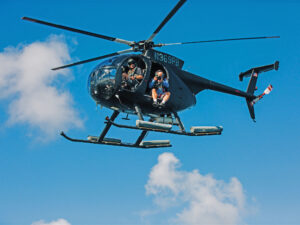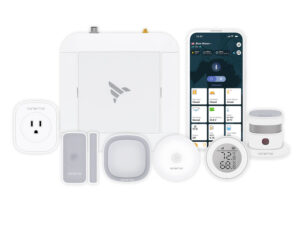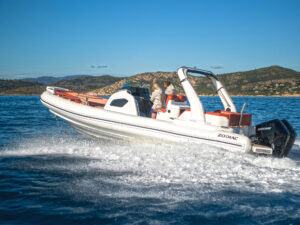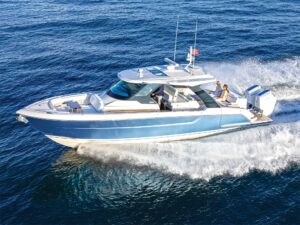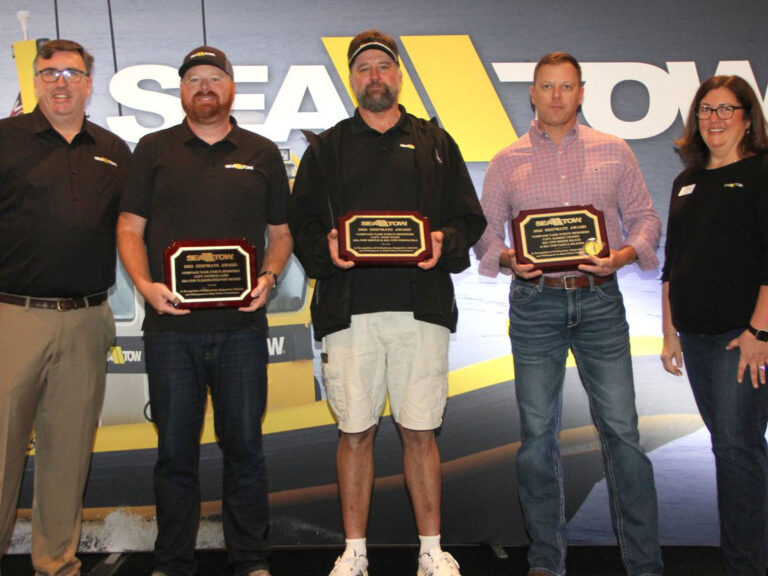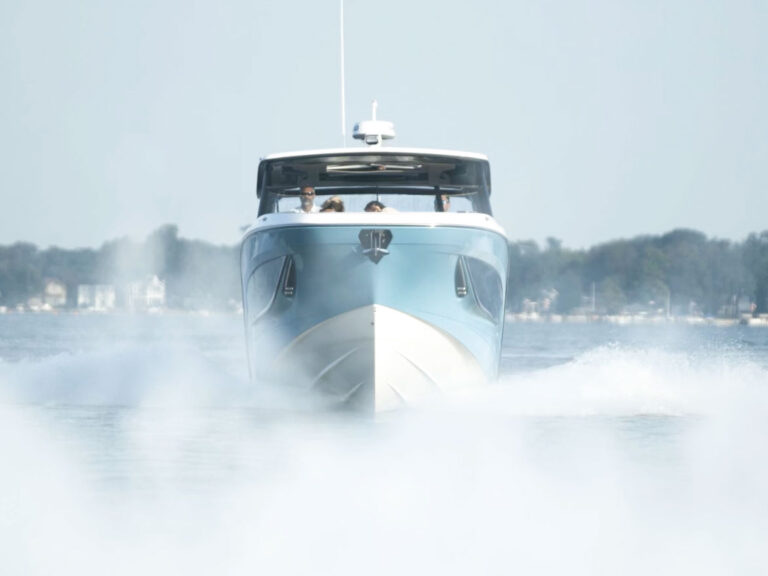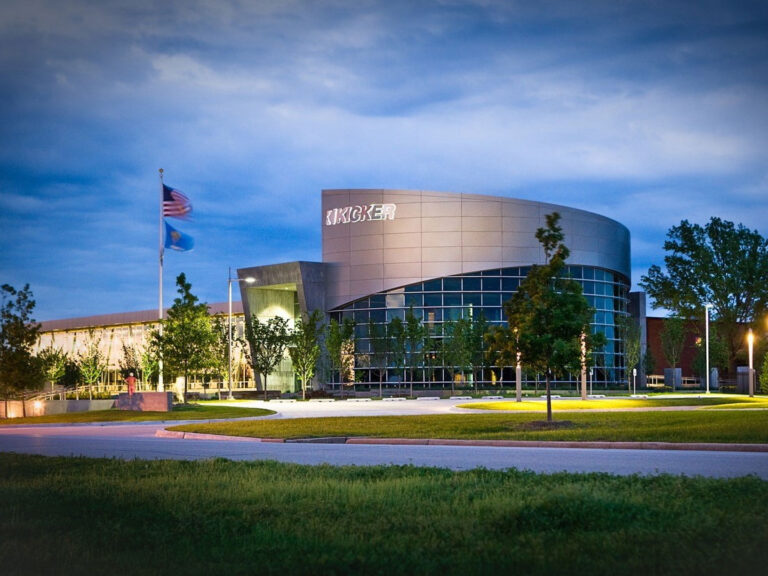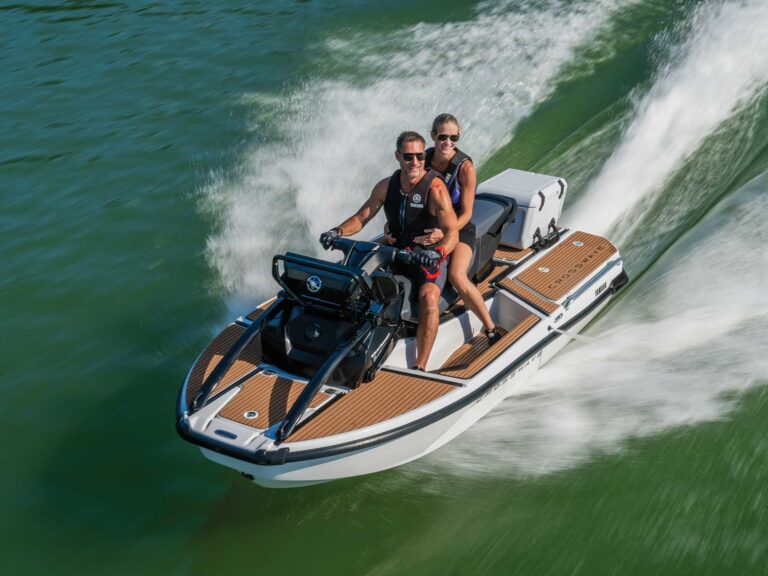Overview
The Leader 12.5 WA is part center-console, part express cruiser, part fishing boat and part cruising. And it fulfills that tripartite mission with very little compromise. But when we firewalled the throttles on triple Yamaha 300 outboards, we knew it could also scratch a performance itch. The Michael Peters hull coupled with 900 Yamaha horsepower delivers sporty performance not usually found in a sedan cruiser.

Engine
Acceleration with the triple Yamaha 300′s proved snappy, planing in 5 seconds, making 30 mph in 10 seconds and topping out at 50 mph—all impressive numbers for a vessel pushing 18,000 pounds displacement, packed with sumptuous living quarters and topside accoutrements that cover fishing, diving, swimming, exploring and outdoor dining. After testing several Jeanneaus, we’ve come to expect this MVP quality in its power boats.
Interior and Accessories
A good place to note this boat’s durability is the hard top over the command deck. It is supported aft by heavy gauge, highly polished, rectangular tube stainless steel, and the hardtop stretches forward to the windshield rim to marry the frame and tempered glass in a structural system that never shuddered or shook in our heavy-handed test driving.

The command deck itself had three comfortable bucket seats for keeping the captain in comfortable touch with crew and vessel. The dash was glossy acrylic, boasting room for large Garmin chart plotter displays, while saving plenty of space for audio, VHF, Command link gauge, bow thruster or windlass controls (if selected).
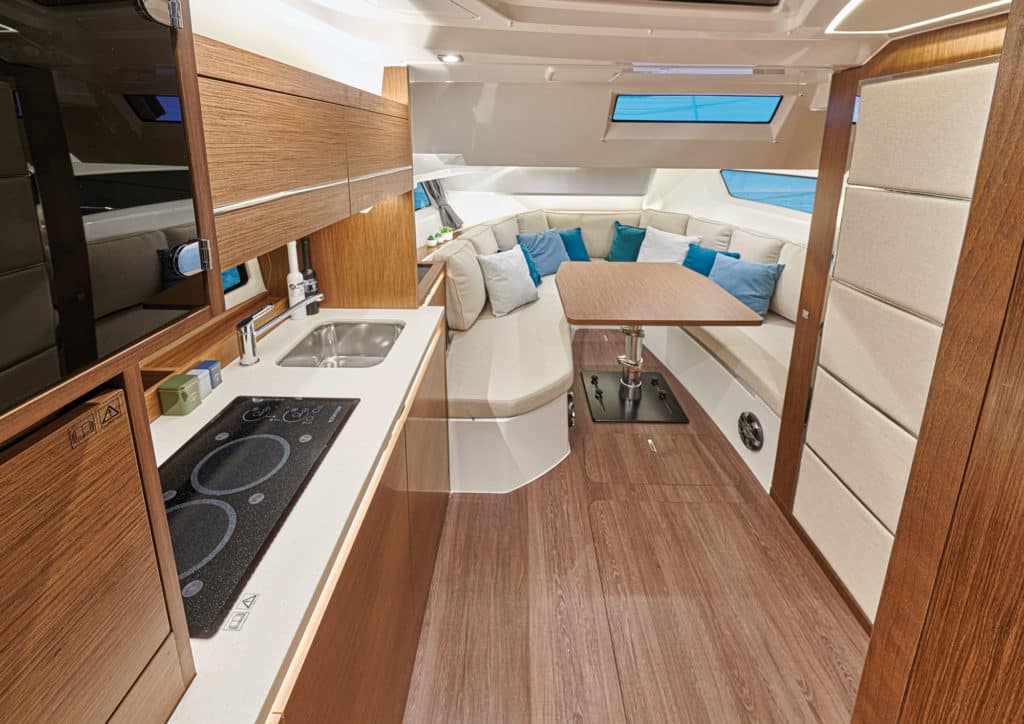
Behind the helm is an entertainment galley with refrigerator (or two, if you choose), a grill, sink and storage for equipment. The cockpit seating includes an L-shaped lounge that begins at the transom boarding steps to port and wraps around to just behind the helm station on the starboard side.

Expand the cockpit, assuming you need more space, by electrically lowering the port side veranda. Add a couple folding chairs there. The bow sports lounges accessed by wide walkways and protected by thick bow rails. Below deck you’ll find choosing which stateroom is the master a coin-flipping affair. The aft cabin can be set up with a wide double and a narrow single or fill the walkway between them with included cushions for a king-size bed. The V-berth forward converts from a luxurious dining area to a wide bed and privacy curtains separate it from the main salon where there’s still another galley and a large head compartment with a shower separated by an acrylic shower door from the head and sink.

Construction and Design
Michael Peters designed the running surface and made the Leader 12.5 fast. He’s been designing Jeanneau hulls since 2002 and while we expected to see steps below the waterline, we did not. This is built on a sharp entry, deep V-bottom with lifting strakes and prominent chines designed to knock down spray. We know the latter worked because we worked the hull and outboards like cheap labor, spinning the power steering wheel and cycling the electronic throttles back and forth, fore and aft, pushing the boat into hard over turns, holding it on plane maintaining better than expected speed in those turns. It has the agility to stretch out like a greyhound on the hunt. We did all this without once wetting the tempered-glass windshield or showering the cockpit with spray.
While one can credit the 12.5 Leader’s performance to the Michael Peters design, don’t discount Jeanneau’s longest-in-industry experience building recreational boats of fiberglass. Jeanneau began its legacy in this art in 1958, eight years after building its first race boat and 22 years before building its first F1 racing boat that dominated the field for several years.
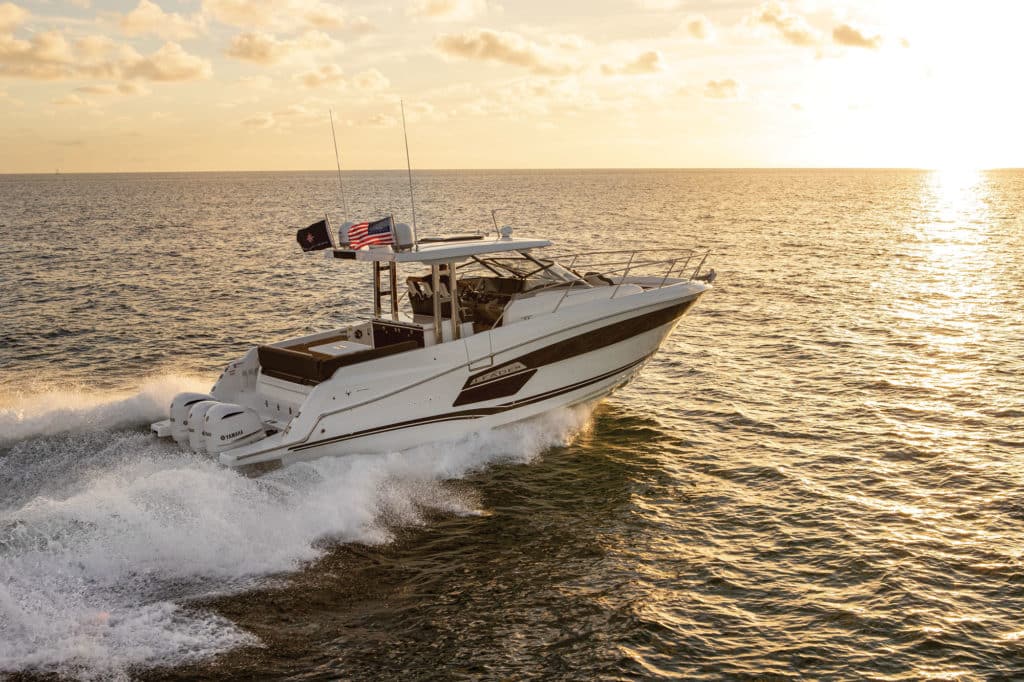
The first fiberglass Jeanneaus were built to look like wood boats—a common tactic for builders adopting the new technology. Over time, Jeanneau developed infused fiberglass techniques and used them on the Leader series. Stringers are fused to the hull, glass is maximized, resin is minimized and hull strength-to-weight ratio is optimized.
Then there’s the “look” of the 12.5. Stately, for a race horse like this and that is compliments of the 20-year partnership between Serrazin Design and Jeanneau’s team. Together they made the style and function of the 12.5 durable and sleek
How We Tested
- Engine: Triple Yamaha F 300 V-6 four-stroke outboards
- Drive/Props: Outboard/15-1/2″ x 17″
- Gear Ratio: 1.75:1 Fuel Load: 150 gal. Water On Board: 0 gal. Crew Weight: 450 lb.
High Points
- Available with Yamaha Helm Master EX Full Maneuverability system with autopilot and joystick.
- Unique console arrangement gives access to the helm deck from port and starboard sides.
- Fusion Audio system with multi-zone control above and belowdecks.
Low Points
- Helm seat bolster cushions were loose and bolsters were difficult to manipulate.
- Acrylic shower door was unusually thin.
Toughest Competitor
It’s tough to find a comparable boat for some vessels and the Leader 12.5 is one of those. You could look at an MJM 43 that makes 53 mph (according to MJM) on triple Merc 350 Verados, but the price tag is going to be pushing $1 million. But, for that you get exotic hardwood and hardwood veneer cabinetry, brightwork, granite counters and other uber-luxurious appointments.
Pricing and Specs
| Price: | $403,180 (base) |
|---|---|
| LOA: | 40′3″ |
| Beam: | 11′9″ |
| Draft (max): | 2′8″ |
| Displacement (approx.): | 17,999 lb. |
| Transom Deadrise: | 21 degrees |
| Bridge Clearance: | 10′4″(without radar) |
| Fuel Capacity: | 304 gal. |
| Max Horsepower: | 900 |
| Seat/Weight Capacity: | 12/8,531 lb. |
| Available Power: | Yamaha Triple 300 outboards |
Speed, Efficiency, Operation

Jeanneau – Annapolis, Maryland; 410-280-9400; jeanneauamerica.com

